Understanding LinkedIn ABM Pipelines: From Setup to Performance Tracking
In B2B marketing, Account-Based Marketing (ABM) has emerged as a strategic approach focusing on targeting and converting specific high-value accounts. LinkedIn, with its professional user base and robust targeting capabilities, has become the premier platform for executing ABM strategies.
However, many organizations struggle to implement effective LinkedIn ABM pipelines that connect initial account targeting to final revenue outcomes. By understanding the complete pipeline structure—from initial setup to performance tracking—marketers can create more effective, measurable ABM programs that deliver consistent results.
Key Highlights
- Well-structured LinkedIn ABM pipelines can improve conversion rates by up to 40% compared to disconnected campaigns
- 97% of marketers report that ABM delivers a higher return on investment than other marketing strategies
- End-to-end pipeline visibility enables accurate attribution of LinkedIn ABM’s impact on revenue
- Integrated technology stacks are essential for seamless data flow throughout the ABM pipeline
- Multi-stage nurture sequences increase engagement by 67% compared to single-touch approaches
- AI-powered tools like Karrot.ai can automate personalization across the entire ABM pipeline
- Closed-loop reporting provides the insights needed for continuous pipeline optimization
- Cross-functional alignment between marketing and sales is critical for pipeline effectiveness
TABLE OF CONTENTS:
The LinkedIn ABM Pipeline Framework
Account-based marketing has transformed B2B marketing, with 70% of marketers now having active ABM programs in place. LinkedIn has emerged as the premier platform for ABM execution due to its professional focus and robust targeting capabilities.
A comprehensive LinkedIn ABM pipeline connects all stages of the account journey—from initial identification to revenue generation. This end-to-end approach ensures that marketing activities are directly linked to business outcomes, enabling accurate measurement and optimization.
The Pipeline Structure
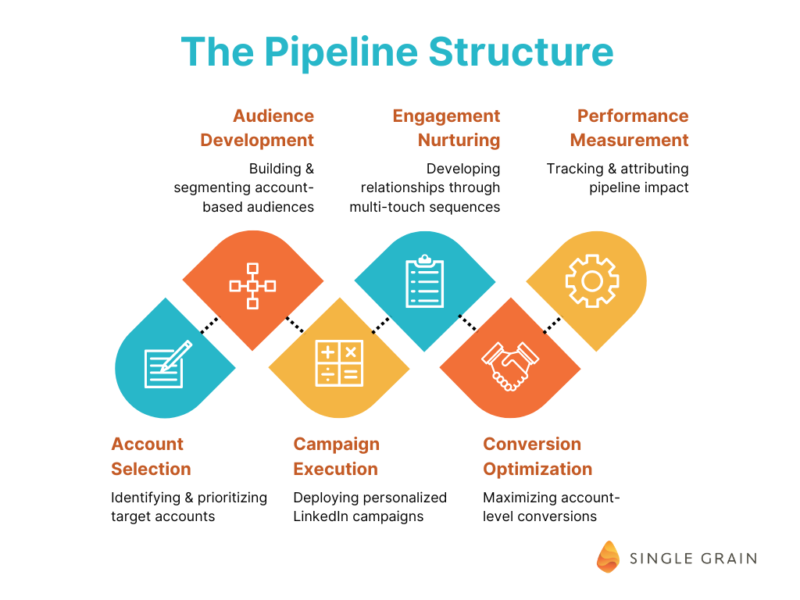
The complete LinkedIn ABM pipeline consists of six interconnected stages:
- Account Selection: Identifying and prioritizing target accounts
- Audience Development: Building and segmenting account-based audiences
- Campaign Execution: Deploying personalized LinkedIn campaigns
- Engagement Nurturing: Developing relationships through multi-touch sequences
- Conversion Optimization: Maximizing account-level conversions
- Performance Measurement: Tracking and attributing pipeline impact
Organizations with well-structured LinkedIn ABM pipelines report 40% higher conversion rates compared to those running disconnected campaigns. This improvement stems from the seamless data flow and activities across the entire account journey.
Stage 1: Account Selection and Prioritization
The foundation of an effective LinkedIn ABM pipeline is strategic account selection:
Ideal Customer Profile Development
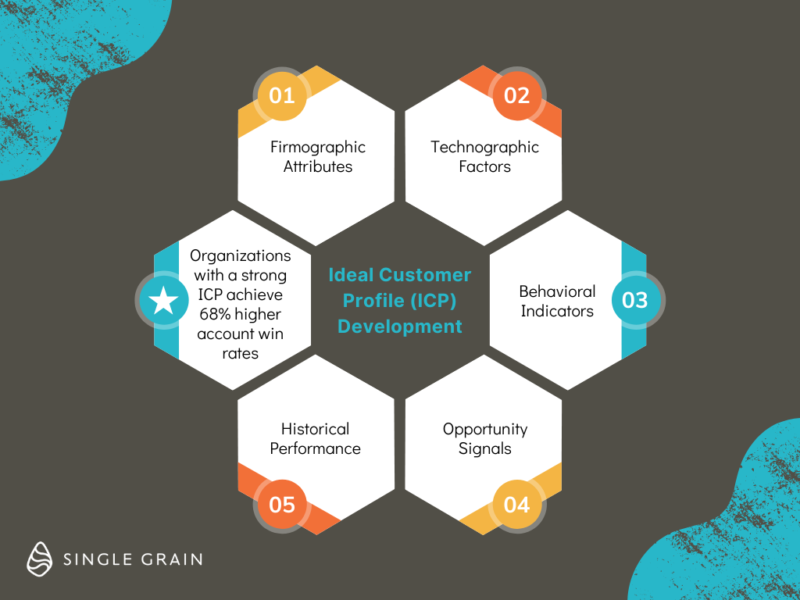
Create a data-driven Ideal Customer Profile (ICP) based on:
- Firmographic attributes: Industry, size, location, growth rate
- Technographic factors: Current technology stack, adoption patterns
- Behavioral indicators: Content engagement, website activity
- Opportunity signals: Funding events, leadership changes, expansions
- Historical performance: Conversion patterns from similar accounts
Organizations with a strong ICP achieve 68% higher account win rates than those using basic targeting approaches.
Account Tiering Framework
Implement a tiered approach to account prioritization:
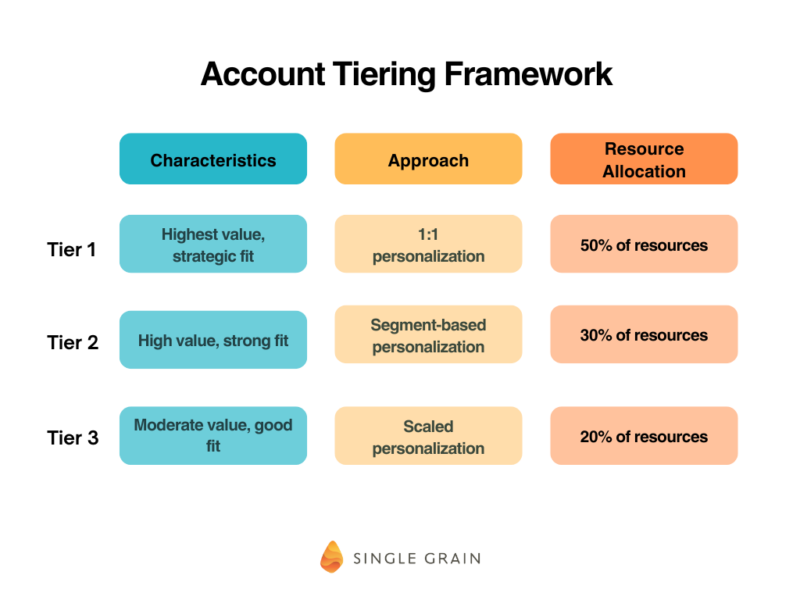
This structured prioritization ensures marketing resources are allocated according to potential account value rather than spread evenly across all targets.
Technology Requirements
Implement these technologies for effective account selection:
- CRM system: For existing customer and prospect data
- Intent data platform: For identifying accounts showing buying signals
- Predictive analytics tools: For scoring and prioritizing accounts
- LinkedIn Sales Navigator: For account research and validation
- ABM platform: For account list management and segmentation
The integration of these technologies creates a data-driven foundation for account selection that significantly outperforms intuition-based targeting.
Stage 2: Audience Development and Segmentation
Once target accounts are selected, the next stage is developing precise LinkedIn audiences:
Multi-Dimensional Segmentation
Implement sophisticated segmentation beyond basic account lists:
- Role-based segments: Different stakeholders within accounts
- Buying stage segments: Accounts at different stages of consideration
- Need-based segments: Accounts with different primary challenges
- Engagement-based segments: Accounts with varying levels of previous interaction
- Account value segments: Tiering based on potential opportunity size
This multi-dimensional approach ensures messaging is relevant to both the account context and the specific individuals being targeted.
LinkedIn Audience Building
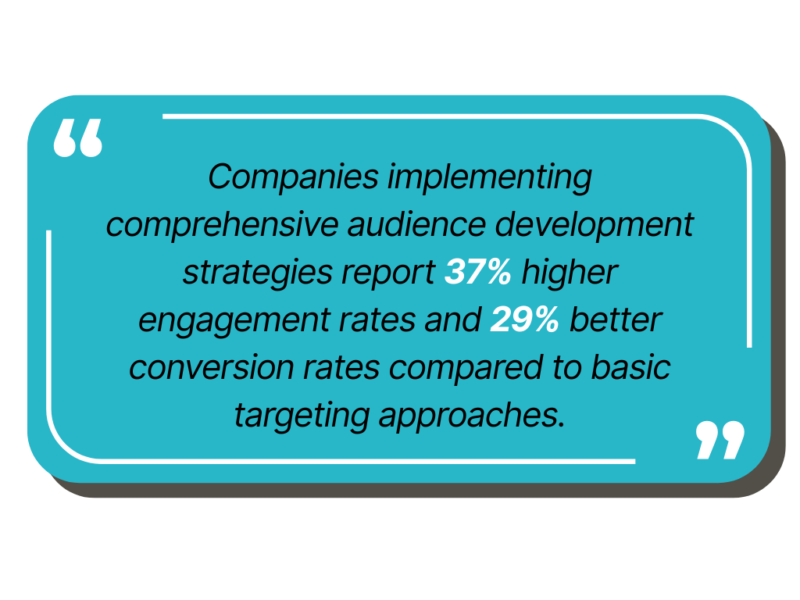
Leverage LinkedIn’s audience capabilities effectively:
- Company targeting: Upload account lists via LinkedIn’s Matched Audiences
- Contact targeting: Upload known contacts within target accounts
- Lookalike expansion: Extend reach to similar accounts and roles
- Website retargeting: Capture account visitors for remarketing
- Engagement retargeting: Retarget users who engaged with previous content
Companies implementing comprehensive audience development strategies report 37% higher engagement rates and 29% better conversion rates compared to basic targeting approaches.
Audience Validation and Refinement
Before launching campaigns, validate audience quality:
- Coverage analysis: Ensure sufficient reach within target accounts
- Role distribution: Verify appropriate stakeholder coverage
- Engagement potential: Assess likelihood of response based on previous patterns
- Competitive exposure: Identify accounts also engaging with competitors
- Sales alignment: Confirm sales team validation of priority accounts
This validation process ensures marketing resources are focused on audiences with the highest potential for engagement and conversion.
Stage 3: Campaign Execution and Management
With audiences defined, the next stage is executing personalized LinkedIn campaigns:
Campaign Architecture
Implement a structured campaign architecture:
Campaign Hierarchy:
– Master Campaign (Account List)
– Industry Segment Campaigns
– Role-Based Ad Sets
– Stage-Specific Ad Variations
– Personalized Creative Elements
This hierarchical approach enables personalization at multiple levels while maintaining organizational clarity and efficiency.
Personalization Strategy

Implement a multi-level personalization approach:
- Account-level personalization: Company name, industry, challenges
- Role-based personalization: Different messaging for various stakeholders
- Stage-based personalization: Content aligned with buying stage
- Behavioral personalization: Messaging based on previous interactions
- Intent-based personalization: Content addressing demonstrated interests
Companies implementing multi-level personalization in their LinkedIn ABM campaigns report conversion rate improvements of up to 70% compared to generic approaches.
The Karrot.ai Advantage
Platforms like Karrot.ai transform campaign execution through:
- Automated creative generation that personalizes ad elements at scale
- Dynamic messaging optimization based on performance data
- Integrated campaign management across the LinkedIn ecosystem
- Personalization at scale without proportional resource requirements
- Continuous creative refreshment to prevent ad fatigue
This AI-powered approach enables true personalization across hundreds or thousands of accounts without overwhelming marketing resources.
Stage 4: Engagement Nurturing and Sequencing
Effective ABM pipelines extend beyond initial engagement to nurture relationships over time:
Multi-Touch Sequence Development
Create structured engagement sequences:
- Awareness content: Industry insights and trend analysis
- Education content: Problem-focused thought leadership
- Solution content: Capability and approach overview
- Validation content: Case studies and social proof
- Action content: Specific next steps and conversion opportunities
Multi-stage nurture sequences increase engagement by 67% compared to single-touch approaches by building relationships through progressive value delivery.
Cross-Channel Coordination
Extend LinkedIn engagement across multiple channels:
- Email follow-up: Personalized outreach based on LinkedIn engagement
- Sales outreach: Coordinated touches from sales representatives
- Retargeting: Display and social media reinforcement
- Direct mail: Physical touchpoints for high-value accounts
- Events: Invitations to webinars and in-person events
This coordinated approach ensures consistent messaging across all touchpoints while increasing overall engagement frequency.
Engagement Acceleration Techniques
Implement strategies to accelerate account engagement:
- Trigger-based sequences: Automated responses to specific behaviors
- Account surge campaigns: Increased activity when buying signals emerge
- Sales activation alerts: Notifications to sales when engagement thresholds are met
- Executive outreach: Strategic involvement of leadership for key accounts
- Custom content creation: Tailored assets for high-priority accounts
These acceleration techniques ensure marketing resources are dynamically allocated based on account engagement patterns and buying signals.
Stage 5: Conversion Optimization
The critical bridge between engagement and revenue is conversion optimization:
Conversion Path Mapping
Map the complete conversion journey for different account segments:
Conversion Paths:
– Awareness Content → Resource Download → Sales Conversation
– Ad Engagement → Webinar Registration → Demo Request
– Thought Leadership → Assessment Tool → Consultation Booking
– Case Study → ROI Calculator → Meeting Scheduler
This mapping ensures each account segment has a clear, logical path from initial engagement to meaningful conversion.
Landing Page Optimization
Implement personalized landing experiences:
- Account-specific messaging: Content tailored to the company’s context
- Role-based value propositions: Different angles for various stakeholders
- Progressive profiling: Incremental information gathering across interactions
- Dynamic content insertion: Automated personalization based on account data
- Optimized form strategy: Balance information capture with conversion rate
Companies implementing personalized landing pages for LinkedIn ABM campaigns report conversion rate improvements of up to 60% compared to generic destinations.
Conversion Acceleration
Deploy techniques to accelerate the conversion process:
- Meeting scheduler integration: Direct calendar booking capabilities
- Chat functionality: Immediate conversation opportunities
- Sales alert system: Real-time notifications of high-intent actions
- Incentivized conversion: Account-specific offers for next steps
- Friction reduction: Simplified forms and conversion processes
These acceleration techniques can reduce the time from initial engagement to meaningful conversation by 40-50%, significantly improving pipeline velocity.
Stage 6: Performance Measurement and Optimization
The final stage of the LinkedIn ABM pipeline is comprehensive measurement and optimization:
Multi-Level Measurement Framework
Implement a structured measurement approach:
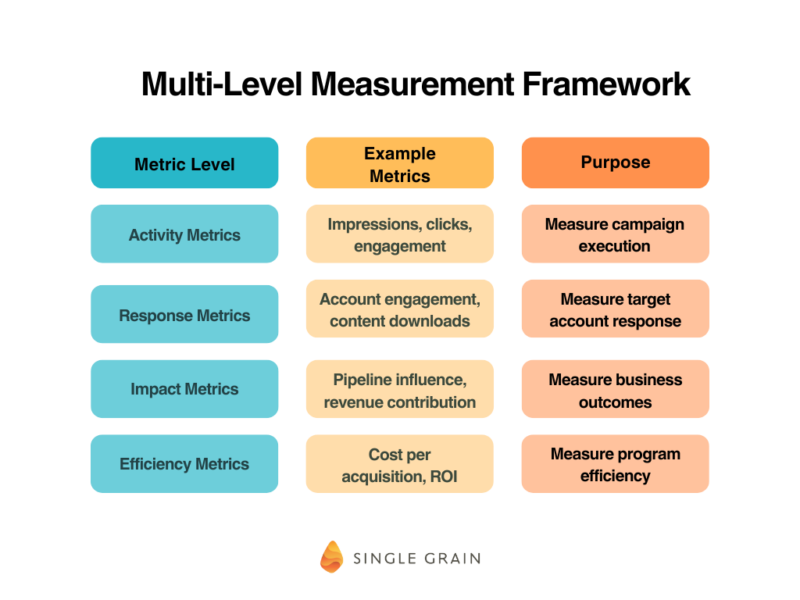
This multi-level approach ensures you track both leading indicators (activity and response) and lagging indicators (impact and efficiency) to get a complete picture of pipeline performance.
Attribution Modeling
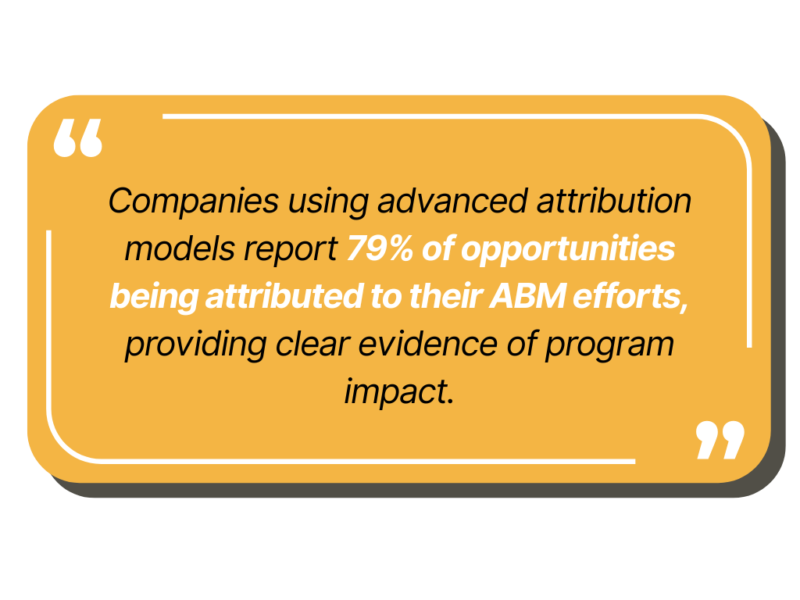
Implement sophisticated attribution to connect LinkedIn ABM to revenue:
- First-touch attribution: Credits the first touchpoint that engaged the account
- Last-touch attribution: Credits the final touchpoint before conversion
- Multi-touch attribution: Distributes credit across all touchpoints
- Position-based attribution: Weights credit based on touchpoint position
- Time-decay attribution: Gives more credit to recent touchpoints
Companies using advanced attribution models report 79% of opportunities being attributed to their ABM efforts, providing clear evidence of program impact.
Closed-Loop Optimization
Implement a continuous optimization cycle:
- Performance analysis: Regular review of metrics across all pipeline stages
- Insight development: Identification of patterns and opportunities
- Hypothesis formation: Creation of testable improvement ideas
- Controlled testing: Systematic validation of hypotheses
- Implementation: Rollout of proven optimizations
- Measurement: Tracking of impact from changes
This closed-loop approach ensures the LinkedIn ABM pipeline continuously improves based on performance data rather than remaining static.
Technology Stack Integration
A seamless LinkedIn ABM pipeline requires integrated technology across all stages:
Core Technology Components
- CRM System: Central database for account and contact information
- Marketing Automation: Orchestration of multi-touch engagement
- LinkedIn Advertising Platform: Campaign execution and management
- ABM Platform: Account targeting and engagement tracking
- Analytics Solution: Performance measurement and attribution
- Personalization Engine: Dynamic content delivery across touchpoints
The integration of these technologies creates a unified data flow that connects all stages of the ABM pipeline.
Data Integration Requirements
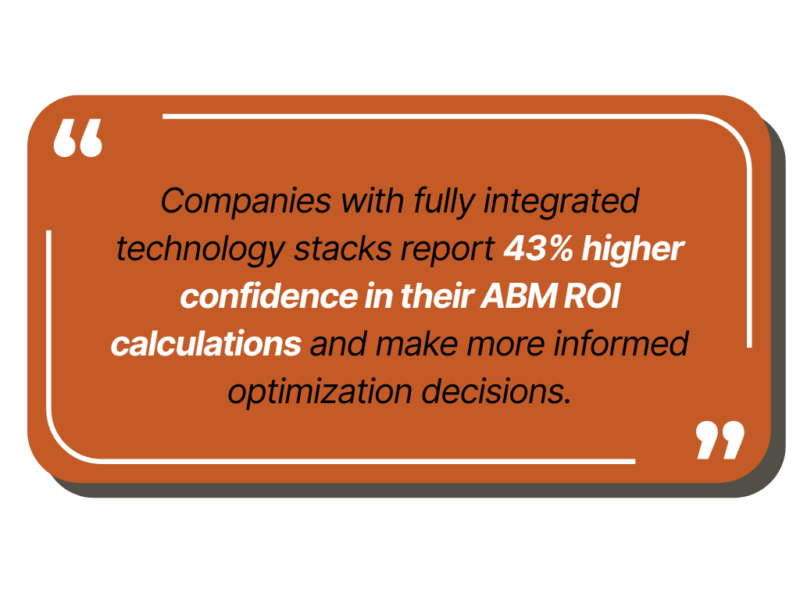
Implement these critical data connections:
- LinkedIn Lead Gen Forms → CRM: For seamless lead capture
- LinkedIn Insight Tag → Website Analytics: For visitor identification
- CRM → LinkedIn Matched Audiences: For audience synchronization
- Engagement Data → Marketing Automation: For behavior-based nurturing
- Opportunity Data → Attribution System: For revenue connection
Companies with fully integrated technology stacks report 43% higher confidence in their ABM ROI calculations and make more informed optimization decisions.
Case Study: Tech Company Transforms Results with Integrated ABM Pipeline
A B2B software company implemented a comprehensive LinkedIn ABM pipeline targeting 500 enterprise accounts. By connecting all stages from account selection to revenue attribution, they:
- Developed a data-driven account selection model that improved targeting precision by 64%
- Created multi-dimensional audience segments across industries and roles
- Implemented personalized LinkedIn campaigns using Karrot.ai
- Developed multi-touch nurture sequences coordinated across channels
- Created personalized conversion paths with account-specific landing pages
- Implemented closed-loop measurement connecting LinkedIn activity to revenue
The results demonstrated the power of an integrated pipeline approach:
- 187% increase in target account engagement
- 64% improvement in MQL-to-opportunity conversion
- 42% reduction in cost-per-acquisition
- 3.2X return on ad spend
- $14.7M in influenced pipeline within 6 months
- 28% shorter sales cycles for engaged accounts
Best Practices for LinkedIn ABM Pipeline Success
To maximize the effectiveness of your LinkedIn ABM pipeline, follow these proven best practices:
- Start with strategic account selection based on data rather than intuition
- Implement multi-dimensional segmentation beyond basic account lists
- Create personalized experiences at every pipeline stage
- Coordinate across channels for consistent multi-touch engagement
- Optimize conversion paths with account-specific experiences
- Implement closed-loop measurement connecting activities to outcomes
- Continuously refine your approach based on performance data
- Maintain sales and marketing alignment throughout the pipeline
- Leverage technology integrations to create seamless data flow
- Invest in AI-powered tools like Karrot.ai to enable personalization at scale
Conclusion
Understanding and implementing a comprehensive LinkedIn ABM pipeline—from setup to performance tracking—represents a significant competitive advantage in today’s B2B marketing landscape. By connecting all stages of the account journey, marketers can create more effective, measurable ABM programs that deliver consistent results.
With 97% of marketers reporting that ABM delivers a higher ROI than other marketing strategies, the investment in a structured pipeline approach is well justified. The key is creating seamless connections between account selection, audience development, campaign execution, engagement nurturing, conversion optimization, and performance measurement.
As you implement these strategies for your LinkedIn ABM programs, consider how automation tools like Karrot.ai can help you achieve personalization at scale across the entire pipeline. By combining strategic thinking with the right technology enablers, you can create LinkedIn ABM campaigns that deliver exceptional, measurable results for your business.




